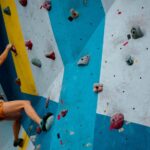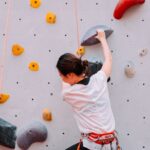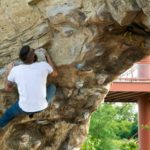“Stronger fingers equals better climbing”
As a climber, this should be your personal mantra. Always remember that finger strength and climbing gains go hand-in-hand. However, to achieve the finger strength you have been yearning for, it is important to adopt effective training methods.
Although the science of climbing is still relatively young several studies have been conducted by exercise physiologists, sports psychologists, and motor learning experts to determine the best method to improve grip and endurance for sports climbing.
Without fail, every study has concluded that hangboard training, whether done at the gym or at home, works. Even a brief training session conducted three to four times a week yields commendable results, especially for individuals who just started off their climbing career.
For years, climbers have heard that finger strength gains come slowly, however, this concept has been disregarded by many studies. A well-thought and well-planned hangboard training protocol augur gains in finger strength at a much faster rate.
We have heard new climbers talk about how hangboards are intimidating and how they feel that it is a tool designed for more advanced climbers. However, that is not true. Yes, there are hangboards that are specifically designed for advanced climbers, but you will find tens and hundreds of hangboards on the market that cater to amateur climbers.
All you have to understand is the method of harnessing the potential of this took. In this article, we have listed some of the best hangboards that you can invest in. Towards the end, we have also curated a Frequently Asked Questions section to answer some of the queries you might have.
If you are still unsure about the benefits and uses of a hangboard, learn more about the effective tool here.
You May Also Enjoy Reading: How Can I Train For Rock Climbing at Home?
Comparison Table
| Features | Metolius Simulator 3D Hangboard | Two Stones Hangboard | Trango Rock Prodigy Hangboard |
|---|---|---|---|
| Construction material | Polyurethane | Wood | Polyurethane |
| Number of holds | 18 | 15 | 30 grip positions |
| Dimensions | 11.32 x 4.09 x 1.97 inches | 21.65 x 5.91 x 1.89 inches | 9.1 inches x 12.1 inches x 2 inches |
| Weight | 15 pounds | 7 pounds | 4.93 pounds per side, 9.86 pounds total |
| Training level | Beginner to Advanced | Beginner to Intermediate | Beginner to Advanced |
| Check Price | Check Price | Check Price |
Best overall hangboard: Metolius Simulator 3D Hangboard
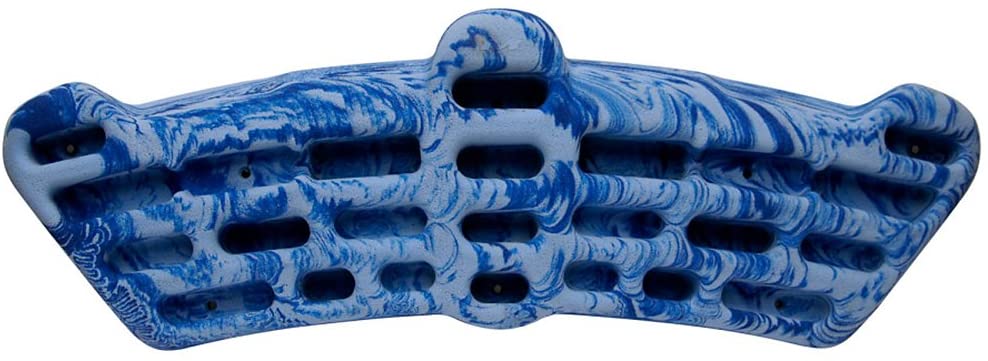
The Metolius Simulator 3D Hangboard is an ideal choice for both beginners and advanced climbers. It comes with a massive selection of edges and pockets that will help you keep up with your gains.
In addition to this, the hangboard mimics the texture of natural rock faces, so that when you go out climbing after training on your hangboard, your fingers don’t have a hard time adjusting to the texture.
Construction and Texture
The hangboard is made using polyester raisin which is why it provides the rock-like texture that most wooden hangboards fail to provide. Since a rough hangboard texture can end up damaging the skin on your fingers, the Metolius Simulator 3D is designed to strike the perfect balance. Its texture is smooth enough to protect the skin of your fingers without affecting your grip.
Edges and Pockets
As mentioned, the hangboard is an all-rounder since it offers edges and pockets that can cater to the needs of both beginner and advanced climbers. It comes with an overhanging design. For the uninitiated, in overhanging hangboards, the pockets and edges towards the top of the board stand further out as compared to the ones near the lower end.
Hence, when you are training, the lower end of the hangboard doesn’t get in your way. This also puts less stress on your shoulders, elbows, and wrists improving the overall efficiency of the training session.
In terms of edges the Metolius Simulator 3D comes with the following options:
- Four sets of different four-finger edges with 1.5-inch, 1-inch, 3/4-inch, and ½-inch depths
- Four sets of three-finger pockets
- Two sets of two-finger pockets
- A single two-finger pocket
- Three standalone three-finger pockets
Mounting
The mounting of the Metolius Simulator 3D is fairly easy. It has been designed for houses that have 8 feet or higher ceilings.
The hangboard can easily fit above average-sized doors. All you need is a mounting board to ensure that the hangboard is screwed firmly its place.
Pros
- The overhanging design puts less pressure on the shoulders and wrists.
- The texture is on point. It strikes the perfect balance between being grippy and smooth.
- The edges and pockets cater to both beginners and advanced climbers.
- The hangboard provides a high value for money.
Cons
- It is slightly larger and bulkier than other hangboards on the market.
For a detailed review of the Metolius Simulator 3D hangboard, read this blog.
Best budget hangboard: Two Stones Indoor Wood Rock Climbing Hangboard

If you are looking for a budget-friendly hangboard that does not compromise on the number of edges and pockets it comes with, the Two Stones Indoor Wood Rock Climbing Hangboard is the answer.
In addition to providing a variety of edges and pockets that cater to the needs of beginner and intermediate climbers, the hangboard is extremely easy to mount. It is constructed using wood, which means it will not give your fingers a hard time.
In terms of value for money, it provides a good balance as compared to other wooden hangboards within the same price bracket. If you are a beginner or an intermediate-level rock climber, this hangboard will definitely help you train for higher-grade rock faces and climbing tracks.
Construction and Texture
The Two Stones Indoor Wood Rock Climbing Hangboard is constructed using 100 percent natural wood. However, since it is relatively small, it only weighs 7 pounds and measures 21.65 inches in length and 5.91 inches in height.
Wooden hangboards are considered ideal if you are just starting with your hangboard training. The smooth texture protects your fingers from scars and you don’t have to worry about any splinters or roughness that will damage your skin.
In addition to this, since the hangboard is CNC milled from a complete woodblock, there will be no scabs and cracking.
Edges and Pockets
Although from the looks of it, this hangboards looks way smaller as compared to its counterparts, it does manage to squeeze in 15 holds designed to train a different set of fingers. There is a pair of outer jugs and two pairs of slopers on the top.
The first row of holds consists of four 1.5 inches finger pockets and a pair of three-finger pockets. The detailed description of the number of holds is as follows:
- 4 Finger Pockets
- 3 Finger Pockets
- 4 Finger Pockets
- 2 Finger Pockets
- 3 Finger Pockets
- 4 Finger Pockets
- 1 Finger Pockets
- 4 Finger Pockets
- 2 Finger Pockets
- 3 Finger Pockets
All the edges and pockets have been created to provide a good progression. Hence, as you develop finger strength, you can move on to more strenuous workouts on the same hangboard.
Mounting
The mounting process of this hangboard is akin to the mounting process of all wooden hangboards. It comes with the required hardware for mounting, so, you don’t have to buy anything separately.
The mounting hardware includes four pieces of M4*50mm screws and three pieces of M4*70mm screws along with 7 pieces of expansion tubes. Moreover, thanks to the expansion tubed, you can directly screw the hangboard on the wall. There is no need for a mounting board.
Pros
- The hangboard has a multifunctional design and it comes with two sets of slopers for warming up.
- All the spare parts required for mounting the tool are included in the package.
- The texture is ideal for individuals who are just starting off with hangboard training.
- It provides good value for money.
Cons
- The width of the hangboard abruptly reduces to 1-inch after the second row.
For a detailed review of the Two Stones Indoor Wood Rock Climbing Hangboard, read this blog.
Best runner up: Trango Rock Prodigy Hangboard

Next up is the Trango Rock Prodigy Hangboard which has a two-part design. This two-part design makes the hangboard ideal for individuals who are looking for a hangboad that will allow them to increase the difficulty level of their training slowly and gradually.
The hangboard has been designed with a systematic collection of edges which makes it a great first hangboard. The best part about this hangboard is that it comes with a tilted angle on the crimp rails and a relatively larger angle on the pinches to prevent any injuries.
The Trango Rock Prodigy Hangboard focuses more on improving the overall efficiency of the workout. This functional training tool will not damage your skin and will provide the means for a progressive workout to keep up with your gains.
Construction and Texture
This Trango hangboard is constructed using Polyurethane. The rigidity and high durability of the material ensure that the hangboard will endure the harshest of conditions without cracking.
As far as the texture is concerned, the Trango Rock Prodigy Hangboard provides a texture that is comparable to the higher-end wooden models. It is neither too smooth nor too grainy.
Edges and Pockets
The versatile edges and pockets that the Trango Rock Prodigy Hangboard makes it one of the best and most unique hangboards on the market. This is solely why it makes a great first hangboard.
You can start off with the easy holds and move towards the relatively difficult holds as you gain finger strength. It comes with edges and pockets that slowly get narrower from right to left. The top set of edges measures 1 ¼-inch in depth. As you go down, it tapers to ¾-inch.
As a demarcation, and to help you understand if you are progressing properly, there are two small bumps on each level. Along with these tapered edges, the Trango hangboard also offers five other pairs of pockets. Each of them is designed for a different function.
Mounting
Since this hangboard has a two-part design, its mounting process is a little tedious as compared to other hangboards on the market. Due to the two-part design, mounting it requires twice the effort. Nevertheless, the width of the hangboard can be tailored according to your needs, which makes it all worth it in the end.
Pros
- The hangboard provides means for versatile and efficient workouts.
- It has tilted rails that are designed to prevent injuries.
- The texture is ideal, it is neither too smooth nor too grainy.
- You can tailor the width of the hangboard according to your needs.
Cons
- The mounting process is slightly tedious.
For a detailed review of the Trango Hangboard, read this blog.
Best Hangboard Under 60 bucks: Yes4All Doorway Hangboard
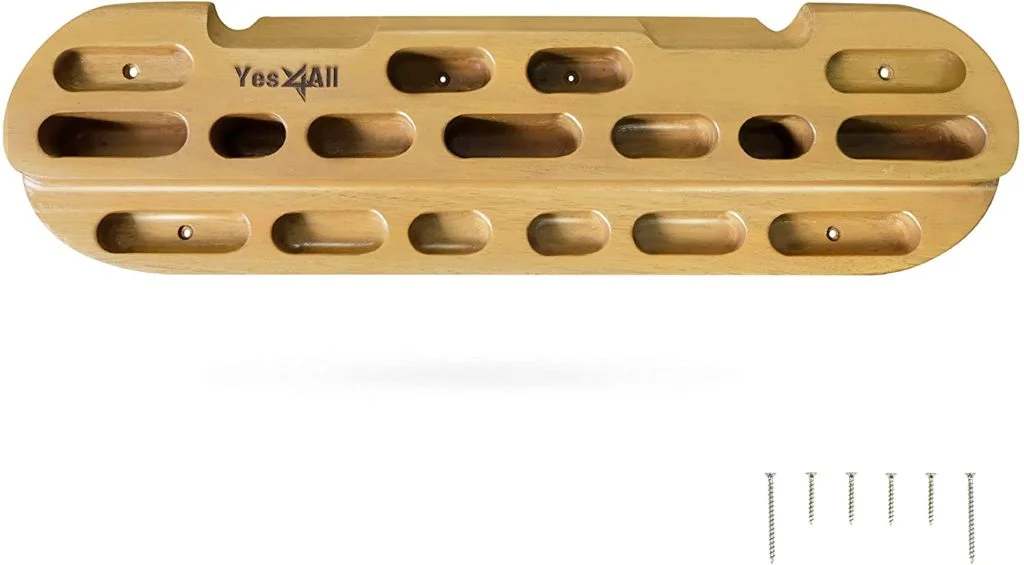
The Yes4All Doorway Hangboard is ideal for individuals who want to experience a premium quality hangboard without spending a lot of money. This hangboard is a dupe for the classic Beastmaker 1000 hangboard.
However, it has been designed to cater to the needs of beginner and advanced climbers. The progression it offers is not enough to fulfill the needs of an advanced climber. Nevertheless, if we only look at the construction, the number of holds offered and the price point, the hangboard offers great value for money.
Construction and Texture
Just like the Beastmaker 1000, the hangboard is constructed using wood that is coated with an anti-slip coating. The board has a smooth texture but the anti-slip coating prevents slipping and provides enough grip. You might face a few scratches here and there on your fingers when you start training initially.
Edges and Pockets
Since the hangboard caters to individuals who are just starting off with hangboard training, it comes with relatively easier edges. The Yes4All Doorway Hangboard features 40 mm edges in all finger sizes. In addition to this, it also offers 12.5 mm and 10 mm edges.
Mounting
Like most wooden hangboards, this hangboard is fairly easy to mount. However, you will need a mounting board to ensure it is installed properly. The best part is that it can easily fit above most doors even if the ceiling is as low as 7 feet.
Pros
- It is lightweight and sturdy.
- The variety of edges and pockets provide ample room for efficient workout sessions.
- It is budget-friendly.
- The mounting process is relatively easy.
Cons
- It does not offer progression in terms of edge sizes.
For a detailed review of the Yes4All Doorway Hangboard, read this blog.
Best Portable Hangboard For Traveling: BG Climbing Hangboard
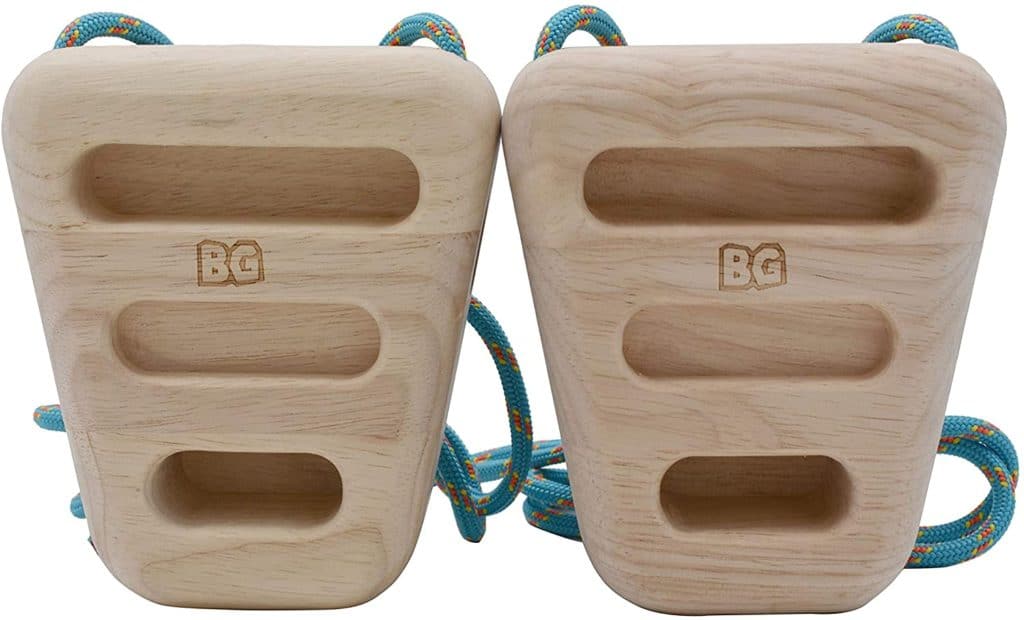
If you travel a lot but don’t want to compromise on your finger strength gains, then the BG Climbing Hangboard is exactly what you are looking for. It is the perfect option for beginners, intermediate as well as advanced level rock climbers who are always on the move.
In addition to this, this hangboard is a great tool for performing a pre-climbing warm-up session. It comes with six pairs of holds that can be used for performing a variety of training positions.
Construction and Texture
The hangboard is a two-part hangboard that can be hung with pull-up bars or tree branches using the rope it comes with. The hangboard is made of 100 percent recycled rubbed wood with a non-slippery coating.
Hence, it is durable and sturdy. In addition to this, despite having a properly polished surface, it is not slippery at all.
Edges and Pockets
As mentioned, the double-sided hangboard comes with a total of six holds on each part. The details are as follows:
- 0.98-inch/25 mm four-finger pockets
- 1.18-inch/30 mm four-finger pockets
- 0.39-inch/10 mm three-finger pocket
- 0.39-inch/45 mm three-finger pocket
- 1.57-inch/40 mm two-finger pocket
- 1.57-inch/15 mm two-finger pocket
Mounting
Since the BG Climbing two-sided hangboard is to be hung with ropes, the mounting process is fairly easy. You don’t have to worry about drilling holes in the wall or attaching it to a plywood panel. All you have to do is hang it from a hook, bar, or tree branch.
Pros
- The hangboard offers a total of 12 holds with a smaller footprint.
- It can be used by beginner as well as advanced-level climbers.
- You can install it in your home gym and take it along while you are traveling.
- The hangboard is constructed using pure rubberwood.
Cons
- It is slightly bulkier than other portable hangboards.
For a detailed review of the BG Climbing Double-Sided Hangboard, read this blog.
Buying Guide
Before deciding upon a hangboard, there are several factors that you must consider. Keep reading to learn more about what you should keep in mind before investing in a hangboard.
Construction Material
Hangboards are usually considered using one of the following three materials:
- Wood,
- Polyester resin
- Polyurethane
Although wood hangboards are generally preferred, they are not usually as durable and robust as polyester resin, and polyurethane hangboards. However, since polyester resin hangboards are very heavy and bulky, most modern hangboards are constructed using polyurethane.
Nevertheless, the choice of material depends on your preference. If you want a more natural and skin-friendly hangboard, wood is the best choice. These hangboards are not harsh on the skin and are lightweight. Moreover, they have less friction.
However, if you are on a budget, go for a polyurethane portable hangboard since wood hangboards are more expensive.
Number of Edges and Pockets
In addition to the material of the hangboard, the number of edges and pockets it comes with greatly affects the quality of your training. The hold size, as well as the number of holds, should be according to your skill level.
The size and shape of the edges and pocket determine the intensity of the workout. Thus, if you are a beginner, go for a hangboard with deeper edges and pockets. The rule of thumb is that as the level of expertise increases the shallowness and size of pockets decrease.
Slopers
Many climbers disregard the importance of slopers while choosing a hangboard. They are used to warm up for hangboard training. If you are unable to properly activate your muscles during the warm-up session, your hangboard training can result in an injury.
Thus, it is very important that the hangboard you are investing in comes with a set of slopers. They are usually rated between 15 degrees to 30 degrees.
Also Read: Ultimate List Of Portable Hangboards [2022]
Frequently Asked Questions
Are wooden hangboards better than polyurethane or molded plastic hangboards?
Both wooden and polyurethane hangboards have their pros and cons. If you have sweaty fingers, then the texture polyurethane or molded plastic hangboards provide will work better for you. On the other hand, if you are planning to perform extensive training sessions with added weights, then wooden hangboards are a better choice.
What is the right technique for safe hangboard training?
No matter what training protocol you choose, the technique and the posture ultimately affect the efficiency and the safety of your workout. It is imperative that you maintain certain tension in your shoulders and upper torso. That can be done by engaging the scapular stabilizers and rotator cuff. Just like other workouts, the “shoulders down, chest out” posture works best with hangboard training.
What can be done to accelerate muscle recovery after hangboard training?
According to research, there are certain nutritional protocols that you can follow. These promote connective tissue recovery as well as support strength gains. You can consume vitamin C-enriched hydrolyzed collagen and Whey protein isolate to accelerate muscle recovery. However, before consuming any supplements, it is always recommended to consult a physician.
What should a hangboard warming up session entail?
For hangboard training, it is advised that you start off with a brief full-body activity that will elevate your heart rate. This can include jogging, cycling, or other similar exercises. After this, perform upper body exercises that engage your shoulder and arm muscles. Conclude the session with finger flexor/extensor stretching.
What should be the frequency of hangboard training?
The frequency of your hangboard training totally depends on the level of climbing you are at and your climbing experience. For beginners, two to three hangboard training sessions per week are more than enough. Advanced climbers can perform up to five training sessions per week. However, it is advised that you give at least two days of rest per week.
How can hangboard injuries be prevented?
To prevent hangboard injuries, keep these tips in mind:
- Never perform a full crimp.
- Make sure your shoulders are retracted and locked down. They should not be sagging by your ears.
- Every time you skip the warm-up, you are readying yourself for injuries. So don’t skip the warm-up session.
- Always warm down after a hangboarding session.
- Stretch your shoulders and fingers after completing a hangboard training session.
- Don’t overdo it.



